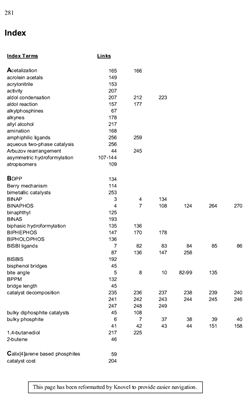Springer. 2002. 300p
In the last decade there have been numerous advances in the area of rhodium-catalyzed hydroformylation, such as highly selective catalysts of industrial importance, new insights into mechanisms of the reaction, very selective asymmetric catalysts, in situ characterization and application to organic synthesis. The views on hydroformylation which still prevail in the current textbooks have become obsolete in several respects. Therefore, it was felt timely to collect these advances in a book. The book contains a series of chapters discussing several rhodium systems arranged according to ligand type, including asymmetric ligands, a chapter on applications in organic chemistry, a chapter on mode processes and separations, and a chapter on catalyst preparation and laboratory techniques. This book concentrates on highlights, rather than a concise review mentioning all articles in just one line. The book aims at an audience of advanced students, experts in the field, and scientists from related fields. The didactic approach also makes it useful as a guide for an advanced course.
In the last decade there have been numerous advances in the area of rhodium-catalyzed hydroformylation, such as highly selective catalysts of industrial importance, new insights into mechanisms of the reaction, very selective asymmetric catalysts, in situ characterization and application to organic synthesis. The views on hydroformylation which still prevail in the current textbooks have become obsolete in several respects. Therefore, it was felt timely to collect these advances in a book. The book contains a series of chapters discussing several rhodium systems arranged according to ligand type, including asymmetric ligands, a chapter on applications in organic chemistry, a chapter on mode processes and separations, and a chapter on catalyst preparation and laboratory techniques. This book concentrates on highlights, rather than a concise review mentioning all articles in just one line. The book aims at an audience of advanced students, experts in the field, and scientists from related fields. The didactic approach also makes it useful as a guide for an advanced course.

